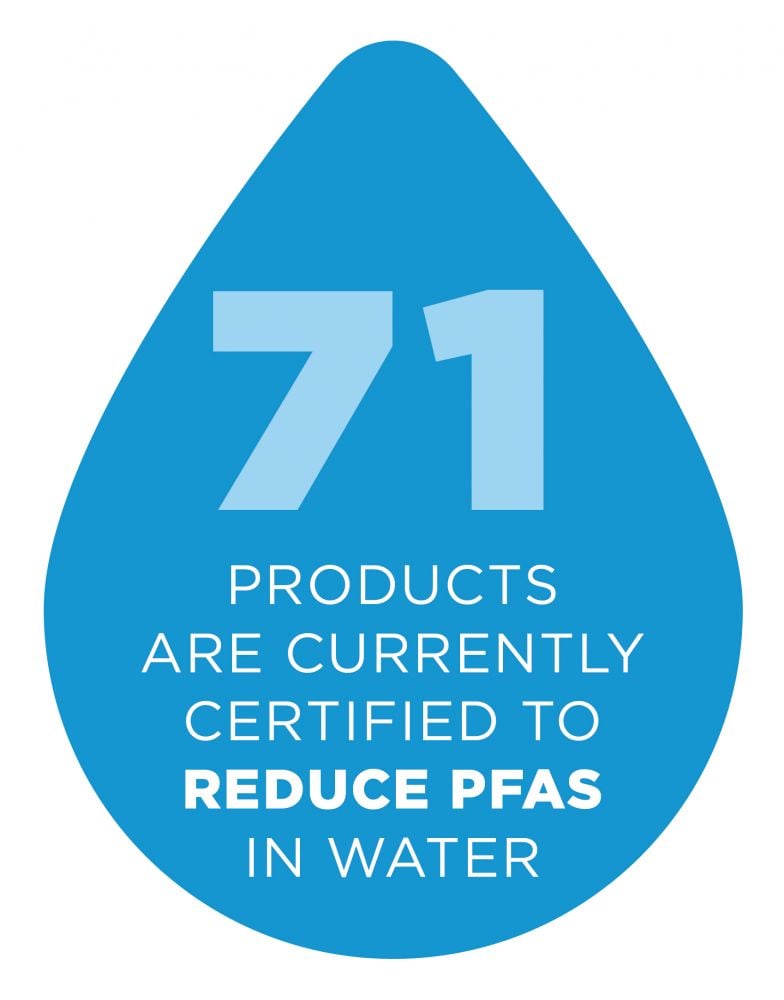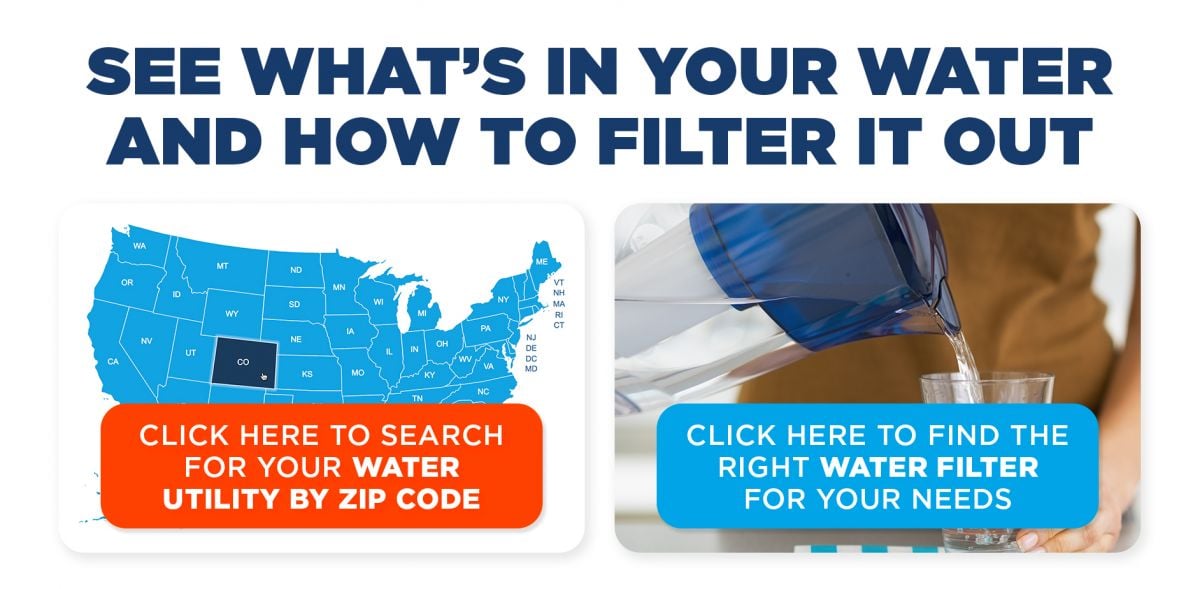
This article was updated Wednesday, March 10, 2021
The family of fluorinated compounds known as PFAS chemicals includes more than 4,700 chemicals – some linked to cancer, thyroid disease, weakened immunity and developmental defects, and others whose health effects are unknown. One thing’s for sure: You don’t want them in your body.
Drinking water is one of the most common sources of exposure. PFAS chemicals could contaminate the drinking water for 200 million Americans nationwide. EWG’s interactive map shows areas of known contamination. If you know or suspect these chemicals are in your tap water, the best way to protect yourself is by installing an in-home water filter. But which kind?

Based on information from state health agencies, testing labs, scientific researchers and water filter companies, the most effective choice for in-home treatment of PFAS-tainted tap water is a reverse osmosis filter, followed by an activated carbon filter – a slightly lower-cost option.
But many questions remain unanswered. More research is urgently needed to better understand how to ensure removal of the many types of PFAS compounds. To help with your choice, below are details of what is currently known.
Disclaimer: EWG is not recommending any specific brand of filter and cannot guarantee that a filter’s performance will match the results reported below.
States Leading Response to PFAS Contamination Crisis
The Environmental Protection Agency has set a health advisory level for the two most-studied PFAS compounds in drinking water – PFOA, formerly used to make DuPont’s Teflon, and PFOS, formerly an ingredient in 3M’s Scotchgard. The advisory level is 70 parts per trillion, or ppt, for the two chemicals combined. But the best and most current scientific research says that’s much too high, and the EPA’s advisory level is not legally enforceable.
That’s why some states with extensive PFAS drinking water contamination are taking steps to set more health-protective limits or advisory levels. For example, New Jersey has set a legal limit of 13 ppt for perfluorononanoic acid, or PFNA, and proposed enforceable limits of 14 ppt for PFOA and 13 ppt for both PFOS. Other states such as Washington, Michigan, and North Carolina are conducting additional testing to further evaluate the extent of contamination in drinking water.
Some of these states have issued recommendations for water filters to remove PFOA and PFOS, including:
Guidance and factsheet documents from these states recommend two types of filters for removing PFAS chemicals: activated carbon and reverse osmosis. The states provide information on the pluses and minuses of the two types, and tips on how to maintain them to ensure effective filtering. They also compare the two types of filter installations: “point of use,” which are installed under the kitchen sink or in the refrigerator, and “point of entry,” which treat the water for the whole house.
In communities with the worst contamination, such as in Minnesota or Michigan, whole-house filtration is often used. It is effective, but expensive in comparison to point-of-use filtration and may not be necessary in most cases. Further, since whole-house systems also remove chlorine, they may introduce additional risks of harmful bacterial growth in plumbing.
Filters Certified for PFAS Chemical Removal
NSF International, a testing and certification company, developed a certification standard for removal of PFOS and PFOA in 2016. The certification requires that the filter reduce these two chemicals only to EPA’s health advisory level of 70 ppt. Currently, 71 products from seven manufacturers are certified to meet this standard.
However, drinking water can contain other PFAS chemicals, sometimes at higher levels than PFOS and PFOA. PFOS and PFOA, which are now banned, are called ‘long-chain’ compounds because they have eight carbon atoms, while the chemicals that have replaced them are called ‘short-chain’ compounds because they have fewer carbon atoms. While similar, these so-called “next-generation” compounds have different molecular structures, and the effectiveness of filters certified for PFOS and PFOA for removal of replacement PFAS chemicals is unknown.
Filter Testing by State Agencies
In 2007, the Minnesota Department of Health commissioned testing of home water filters to determine their efficacy in removing PFAS. Six activated carbon filters and eight reverse osmosis filter types were tested. The tests determined that four of the six carbon filters and seven of the eight reverse osmosis filters provided sufficient reduction of PFAS chemicals. In field testing, four activated carbon devices and seven reverse osmosis systems, all equipped in tandem with activated carbon filters, removed PFOA, PFOS and PFBA to the detection limit of 50 ppt.
The study noted that for the carbon filters, the effectiveness of removal of PFOA, PFOS and another chemical, PFBA, decreased over operating life in five of the six filters tested in laboratory conditions. That means that users will have to replace the filters on the recommended schedule to ensure effective filtration of PFAS chemicals.
In 2017, Minnesota released the results of a study for a faucet-mounted carbon filter made by PUR. The filter was tested for seven PFAS chemicals typically seen in groundwater in Washington County in Minnesota. The state concluded that this low-cost filter could be used to effectively reduce PFAS contamination. Six of seven contaminants including PFOA and PFOS were removed below the reporting limits of 5 and 10 ppt, respectively, achieved in the 2017 study. In contrast, levels of the shorter chain PFBA were only reduced by 75 percent.
Filter Testing by Academic Institutions
Professor Detlef Knappe and his research group at North Carolina State University have independently tested numerous home water filter options. To date they have tested at least 27 home-use filters.
Last year, Knappe told the Star News of Wilmington, N.C. that an under-sink reverse osmosis filter was probably the best choice for home treatment. He said it’s not only effective, but its continued effectiveness can be easily verified with an electrical conductivity tester, an inexpensive tool that people can use at home.
Detailed testing results were publicly presented in 2017 for four under-sink reverse osmosis filters and one whole-house activated carbon filter. These filters that were tested for removal of a dozen PFAS chemicals, including both long-chain and short-chain compounds.
Three out of four reverse osmosis filters reduced the long-chain compounds to below 10 ppt, with the other filter reducing them to a slightly higher level. The four reverse osmosis systems also removed between 95 and 99 percent of short-chain compounds.
EWG Contacted Water Filter Companies
EWG surveyed 51 water filter companies to find out about their filters’ capabilities to remove PFAS. We heard back from 14 companies, but only four of them verified that their filters remove any PFAS chemicals.
Only Berkey provided EWG with test data for their carbon filters, which reported removal of nine PFAS chemicals, including PFOA and PFOS, all below the detection limit of 2 ppt. However, only 25 gallons of water were filtered, instead of the recommended 6,000 gallons to measure lifetime efficacy. Aqua Systems and Triple Clear stated that removal for their products was only to the EPA advisory levels and Crystal Quest reported that removal was variable.

Reverse Osmosis Filters vs. Activated Carbon Filters
In general, reverse osmosis systems more consistently removed PFAS compared to activated carbon systems.
Most reverse osmosis systems also have the benefit of an additional activated carbon filtration stage included in the system. Reverse osmosis systems remove a wider range of other contaminants from drinking water and their effectiveness can be tested at home using an electrical conductivity meter. But activated carbon filter systems are significantly less expensive than reverse osmosis systems. Carbon filters must be changed on schedule as they will lose their effectiveness over time.
Recommendations
- Check out EWG’s interactive PFAS map to see if your drinking water has high levels of PFAS chemicals or if there is a contamination site near your community.
- If you live in an area with contamination, contact your local health department for current information.
- If you have a private well and suspect PFAS contamination, consult your state health department about having your well tested.
- The best bet to filter PFAS chemicals out of your water is an in-home reverse osmosis filter under your sink or at your tap. To ensure that the reverse osmosis filter is working, use an inexpensive conductivity meter. These filter systems remove ions and total dissolved solids in addition to other contaminants, and a low conductivity reading for the filtered water indicates that the filter is overall effective.
- You can also consider an activated carbon filter that will most often provide effective removal. Results have been inconsistent and the filters become less effective with time. If possible, choose a filter that has been tested for PFOS, PFOA and additional PFAS chemicals that may be present in your water.
EWG Research Intern Michael Ong, Research Analyst Carla Burns, and Senior Scientists Tasha Stoiber, Ph.D., and David Andrews, Ph.D contributed to research for this project.



